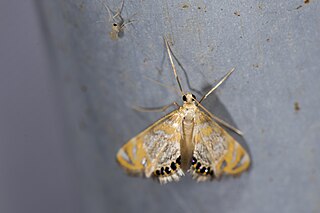
The Crambidae are the grass moth family of lepidopterans. They are variable in appearance, the nominal subfamily Crambinae taking up closely folded postures on grass stems where they are inconspicuous, while other subfamilies include brightly coloured and patterned insects which rest in wing-spread attitudes.

The Pyralidae, commonly called pyralid moths, snout moths or grass moths, are a family of Lepidoptera in the ditrysian superfamily Pyraloidea. In many classifications, the grass moths (Crambidae) are included in the Pyralidae as a subfamily, making the combined group one of the largest families in the Lepidoptera. The latest review by Eugene G. Munroe and Maria Alma Solis retain the Crambidae as a full family of Pyraloidea.

The Pyraloidea are a moth superfamily containing about 16,000 described species worldwide, and probably at least as many more remain to be described. They are generally fairly small moths, and as such, they have been traditionally associated with the paraphyletic Microlepidoptera.

In biology and medicine, feminization is the development in an organism of physical characteristics that are usually unique to the female of the species. This may represent a normal developmental process, contributing to sexual differentiation. Feminization can also be induced by environmental factors, and this phenomenon has been observed in several animal species. In the case of transgender hormone therapy, it is intentionally induced artificially.

Ostrinia is a genus of moths in the family Crambidae described by Jacob Hübner in 1825. Several of them, including the European corn borer, are agricultural pests.

Nymphicula is a genus of moths of the family Crambidae.

Ostrinia palustralis is a species of moth in the family Crambidae described by Jacob Hübner in 1796. It has a trans-Palearctic distribution. In Europe, it is found from Sweden south to Italy and east through eastern Europe to Russia. However, it is absent from the western part of the Balkan Peninsula.
Ostrinia scapulalis, the adzuki bean borer or adzuki bean worm, is a species of moth in the family Crambidae. It was described by Francis Walker in 1859. It is one of 20 moths in the genus Ostrinia and is of Eurasian origin. The larvae have a gray mid-dorsal line and can be light pink or beige. The adult adzuki bean borer has a yellowish-brown forewing with jagged lines and variable darker shading, with a wingspan that ranges from 20 to 32 mm. The moths of this species are nocturnal and tend to be attracted to light.

Ostrinia furnacalis is a species of moth in the family Crambidae, the grass moths. It was described by Achille Guenée in 1854 and is known by the common name Asian corn borer since this species is found in Asia and feeds mainly on corn crop. The moth is found from China to Australia, including in Java, Sulawesi, the Philippines, Borneo, New Guinea, the Solomon Islands, and Micronesia. The Asian corn borer is part of the species complex, Ostrinia, in which members are difficult to distinguish based on appearance. Other Ostrinia such as O. orientalis, O. scapulalis, O. zealis, and O. zaguliaevi can occur with O. furnacalis, and the taxa can be hard to tell apart.
Elophila fengwhanalis is a moth in the family Crambidae. It was described by Pryer in 1877. It is found in Japan, China and Korea.

Elophila turbata is a moth in the family Crambidae found in Africa and Asia. It was first described by the English entomologist Arthur Gardiner Butler in 1881 from a specimen found in Yokohama, Japan.
Ostrinia latipennis is a moth in the family Crambidae. It was described by Warren in 1892. It is found in Japan and the Russian Far East.
Ostrinia marginalis is a moth in the family Crambidae. It was described by Francis Walker in 1866. It is found in North America, where it has been recorded from Newfoundland and Maine west to Alberta, the Northwest Territories and Yukon. The habitat consists of bogs and marshes.
Ostrinia obumbratalis, the smartweed borer, is a moth in the family Crambidae. It was described by Julius Lederer in 1863. It is found in North America, where it has been recorded from New Brunswick and Manitoba to Louisiana and Florida.

Ostrinia penitalis, the American lotus borer, is a moth in the family Crambidae. It was described by Augustus Radcliffe Grote in 1876. It is found from Mexico, through Central America to Amazonas, Brazil. It is also found in North America, where it has been recorded from Quebec to British Columbia and most of the United States. The habitat consists of marshes and pondsides.
Ostrinia zaguliaevi is a moth in the family Crambidae. It was described by Akira Mutuura and Eugene G. Munroe in 1970. It is found in the Russian Far East, Japan and China.

Ostrinia zealis is a moth in the family Crambidae. It was described by Achille Guenée in 1854. It is found in the Russian Far East, Japan, China and India.
Sinibotys butleri is a snout moth in the subfamily Pyraustinae in the family Crambidae. It was described in the genus Crocidophora by Richard South in 1901 based on a single female imago collected in Ningbo in China's Zhejiang province. The species is sexually dimorphic, with females exhibiting shorter, less pointed forewings than the males. The imagines and genitalia of the species are illustrated in Lee et al. (2018).
Herpetogramma stultalis is a moth in the family Crambidae. It was described by Francis Walker in 1859. It is found in Malaysia, India, Sri Lanka, China, Japan, Pakistan, Papua New Guinea and Australia, where it has been recorded from Queensland. In Africa, it has been recorded from the Democratic Republic of the Congo and Réunion.
Eugene Gordon Munroe was a Canadian entomologist who discovered numerous species of insects. He worked for the Insect Systematics and Biological Control Unit, Entomology Division in Ottawa, Canada.










